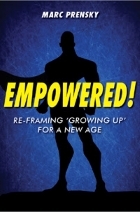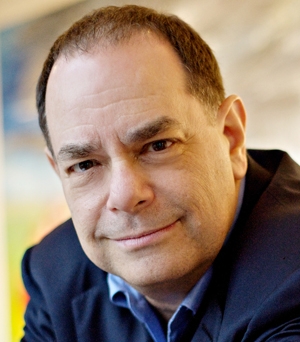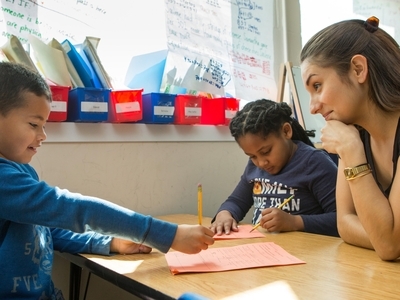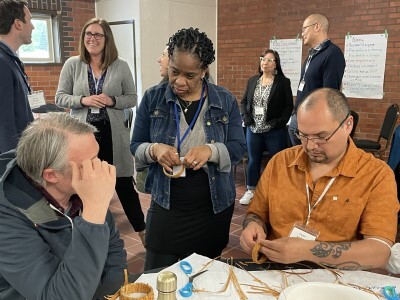EMPOWERED! Chapter 2. A New Generation Seeing Things in a New Way, Part 2
Topics

Next generation learning is all about everyone in the system—from students through teachers to policymakers—taking charge of their own learning, development, and work. That doesn’t happen by forcing change through mandates and compliance. It happens by creating the environment and the equity of opportunity for everyone in the system to do their best possible work.
The idea of Digital Natives and Digital Immigrants helped us make sense of generational changes. What other re-framing can help us support today’s youth?
Note: This article is a reprint of the second half of “Chapter 2: Seeing Things in a New Way” from the author’s book, EMPOWERED! Re-framing ‘Growing Up’ for a New Age. Read the first part of Chapter 2.

“Muscle Memory”
Changing one’s frames is crucial for making changes in behavior—the beliefs represented by our frames determine everything we do or don’t do. But while frame change is a required first step, just changing one’s frame(s) doesn’t necessarily, by itself, lead to behavior change. Our behavior in an old frame often becomes automatic—some refer to this, metaphorically, as “muscle memory” (term from Guido van Nispen). Neuroscientists sometimes call it “zombie” behavior. At times we have gotten so accustomed to doing something in a particular way that even when our beliefs change we still do the old things—knowing they are wrong or ineffective. This so-called “muscle memory” in humans plays a large part in preventing needed changes from taking place. Education—where many practitioners already agree they are not doing the right thing for their students—is one of the prime examples.
What people in that position need, I believe, is a clear vision of what they can do instead. That is something I hope to provide in this book.
Re-Frames Can Take Time
Some re-framing takes a long time to be widely accepted. Today, we are in the middle of the kind of “crisis” period that Thomas Kuhn says comes (in his famous book The Structure of Scientific Revolution) whenever we are changing frames. (Kuhn calls frames “paradigms.”) Humans are now finding many of our old frames, beliefs, paradigms, and worldviews don’t fit the new world we are entering. Today the world is currently going through a process of re-framing a great many things in our lives—at different speeds in different places. For example, the world is only partly through a re-frame that skin color in people, like paint color in cars, doesn’t really matter. Humans are also going through re-frames about how we view women, same sex couples, physical and sexual abusers, individuals who are LGBTQ+, and many other things. People generally accept new frames gradually, as they see they make more sense, and are more useful explanations of their world. All the world’s big re-frames took hold because they were more useful in some way.
In order to fully understand our changing world additional re-frames are needed—and they are coming, as we will see throughout this book. One of the biggest, I believe, is changing the world’s frame regarding young people. That is what this book, in its essence, is about. It is also why we need to think on a 20-year time horizon—that is the amount of time it will take for this new generation, with its different beliefs, to rise to adulthood.
How Re-Framing Can Help
One of the best examples of how re-framing can help comes from the work of Carol Dweck. She has suggested students reframe how they see themselves—from having a “Fixed Mindset” to having a “Growth Mindset.” This re-frame alone changes, in a positive way, how many behave. An entrepreneurial coach, Peter Diamandis, offers his own collection of alternative “mindsets” to budding entrepreneurs—regarding Abundance, Exponential Growth, Longevity, and more—to help entrepreneurs act differently in building businesses.
Re-framing is useful—and often required—to make the world clearer and more understandable—particularly in times of change.
Why Re-Frame?
Re-framing is useful—and often required—to make the world clearer and more understandable—particularly in times of change. Re-frames can be seen as alternative stories or narratives that we choose to tell ourselves and accept about how the world is and how it works. They are “updates” of the “shared myths,” described by Yuval Noah Harari, that help large groups of people move in common directions.
For example, when natural disasters hurt communities deeply a re-frame to seeing a “divine being” as controlling them for its own unknown purposes, rather than their just being random, can be very helpful. When fossils and other evidence indicating progressive changes in various species are discovered, a re-frame by scientists regarding how the world came into being—from “God created” to “natural selection”—may be more useful to them.
People often tend to seek out others with the same frames. This is partly what leads to cultures.
Criteria for Re-Framing
The best criteria for choosing a frame are usefulness and helpfulness (although these are not always the ones used.) Frames are best seen not as “right” or “wrong” but rather as more, or less, helpful and useful. The “lenses” through which we choose to look at the world are part of our self-definition. Each of us can, and does, choose the frame(s) we use.
In essence, re-framing is just looking at, or seeing, the same things differently. A re-frame can be just a change in perspective, such as putting a positive, rather than a negative, spin on some thing or event (e.g., seeing the glass as half-full rather than half-empty). The world was famously re-framed for singer Elton John by his continually wearing rose-colored glasses. (This does, indeed, make the world look “rosier.” I recommend trying it, at least once.)
Big re-frames, such as “the earth being a globe,” or the “growth mindset,” or “abundance, not scarcity,” can open up whole new options and worlds, and lead to very different actions on our part.
Many people in the world, as I write, are currently going through a re-framing from “we seem to be going through a hot spell” to “the global climate is changing.” Others resist adopting this new frame. It remains to be seen how far this re-framing will go and what actions it will lead to.
I See New Frames Often
As I look at the world, and the way others have framed it, re-frames frequently occur to me. Whenever most are looking at the world in one way, I am inspired to try to look at it in another. Seeking a new perspective has always been more helpful to me than going incrementally further in the same direction.
I thank the Boston Consulting Group, and my 6 years there, for helping develop my ability to do large-scale re-framing of whole industries. Here I’m trying to apply some of this to humanity and our times.
Re-framing doesn’t always produce useful results—but it very often does. In the search for new solutions, it is always worth a try.
Nothing besides the new names I gave the generations— i.e., the frame—actually changed. But you can tell a new frame is helpful when people start using it, and don’t stop.
Digital Natives
Of all the re-frames I’ve ever done over my life, the one that is known and useful to the most people is my classifying of humans, around the turn of the millennium, as “Digital Natives” and “Digital Immigrants.” A great many criticized this framing as an over-generalization, and found reasons to question it. But the frame has stuck around—most likely because it contains a useful and helpful nugget of truth.
Around the year 2000, as I watched the young people working in my company at that time, I began to see new generational changes in a new way—not just as the old, traditional process of youth rebellion, but as something new and different—something for which people—especially parents—didn’t have a good explanation, or “frame.” In an article in On the Horizon, an obscure online journal, I re-framed these young people as “digital natives” (i.e., native speakers of the digital language) and their parents as “digital immigrants” (i.e., people who had learned “digital” as a second language). Little did I know at the time the impact this re-frame would have.
Nothing besides the new names I gave the generations— i.e., the frame—actually changed. But you can tell a new frame is helpful when people start using it, and don’t stop. Today, two decades later, the terms Digital Natives and Digital Immigrants still show up daily around the world in stories and headlines. They have entered the English lexicon and can be found in the Oxford English Dictionary. I am sure those words will show up on my tombstone, should I have one. :)
Additional Re-Frames
This book is about a number of additional re-frames, lenses, and perspectives that have occurred to me in the two decades since. I have found all of them helpful in making sense of the coming world of the mid-to-late 21st century, i.e., the world into which today’s young people are growing up. I hope they are helpful to you as well.
New Frames
In each of the chapters of the book I present a number of re-frames that I think are useful for better understanding and for dealing with the mid-to-late 21st century—the time in which our children and grandchildren will live. You might find some of them more “radical” than others. But my hope is that all of them will help you consider what’s coming in a different way. What you do with that is entirely up to you. (Should you agree with all of them, I want to know who you are!)
Structure
Within a larger, overall re-framing of “A New Age of Empowerment,” I will try to re-frame Who Young People Are, Where They Live, Their Beliefs, Their Needs, Their Future, What’s Universal for Them, What They are Called, How They Grow Up, Their Skills, Their Curricula, Learning, Work, and even Their View of Humanity.
And all in under 280 pages!
My guess is that some of these new re-frames will be unsettling, and even disturbing to you. Some of the most radical include seeing humans as becoming symbiotic with technology, seeing learning as no longer the main goal for young people, and seeing reading, writing, and arithmetic as no longer the basics all future young people need. My goal is not just to provoke you (although I hope I do!), but to give you new and different perspectives to think about. I hope, as you read, you will concur with what I consider the highest praise I ever get: “He made me think differently!”
At the end of each chapter I will include “Harbingers”—short vignettes of people who have inspired my re-framings, and I conclude each chapter with questions for you to reflect on.
Let’s start!
But Wait…
But before we begin, I offer you an option.
I begin the book with the overall, general picture of how things are changing, but you may be particularly interested in the implications of that picture, i.e., the specific re-frames I offer for our young people’s “growing up.” That includes the implications of the New Age of Empowerment for learning, the school years, curricula, basics, skills, assessment, parenting, and work. If you seek this information first, you can go directly to those implications—which comprise Parts III and IV of this book—by turning now to either Chapter 11 (Re-framing Learning), or Part IV (Re-framing the 21st Century Journey of Growing Up Empowered.)
If that’s not what you need immediately, then let us begin with the overall picture, by re-framing the times in which all our young people will live—either already today, or within their lifetimes.
| EMPOWERED! Re-Framing Growing Up for a New Generation, Part 2Harbingers |
| Among the many school-age teams I find particularly interesting are: (1) a class of 3-year-olds in Spain who designed—and got their town mayor to install—lower waste bins on city poles (Watch We want bins as tall as us); and (2) a team of middle school girls in Georgia (U.S.A.) The girls not only 3D-printed prosthetic hands, but reached out as well via social media to find young people who needed them. (Watch How 3-D printed arms are changing kids' lives around the world) Details on these two teams—and over 100 other young people and teams who are harbingers of what is to come—can be found at https://btwdatabase.org. |
| Reflection Questions |
| If you have previously heard of my (now 20-year-old) reframing of today’s young people as Digital Natives, and their parents as Digital Immigrants, was this reframing helpful to you? Why or why not? Have you done any re-framing of your own? |
Read More: EMPOWERED!
- Chapter 1: Re-Framing Growing Up for a New Generation, Part 1 and Part 2
- Chapter 2: A New Generation Seeing Things in a New Way, Part 1
- Chapter 3: Re-Framing Our Young People's Times, Part 1 and Part 2
- Chapter 4: Re-Framing Who Young People Are, Part 1 and Part 2
- Chapter 5: Re-Framing Where Young People Will Live, Part 1 and Part 2
- Chapter 6: Re-Framing What Young People Believe, Part 1 and Part 2
The full book is available on Amazon.
Photo at top by Allison Shelley for EDUimages, CC BY-NC 4.0




